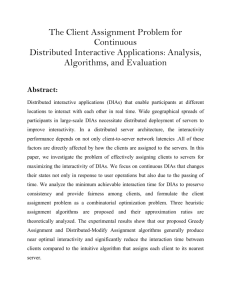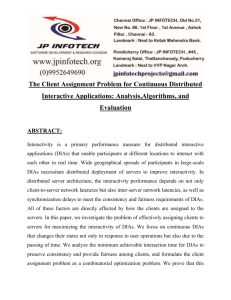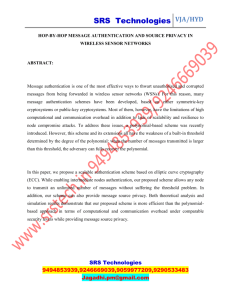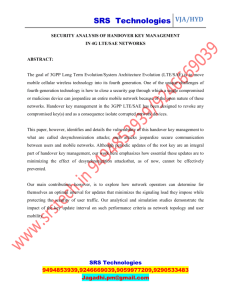server algorithms
advertisement
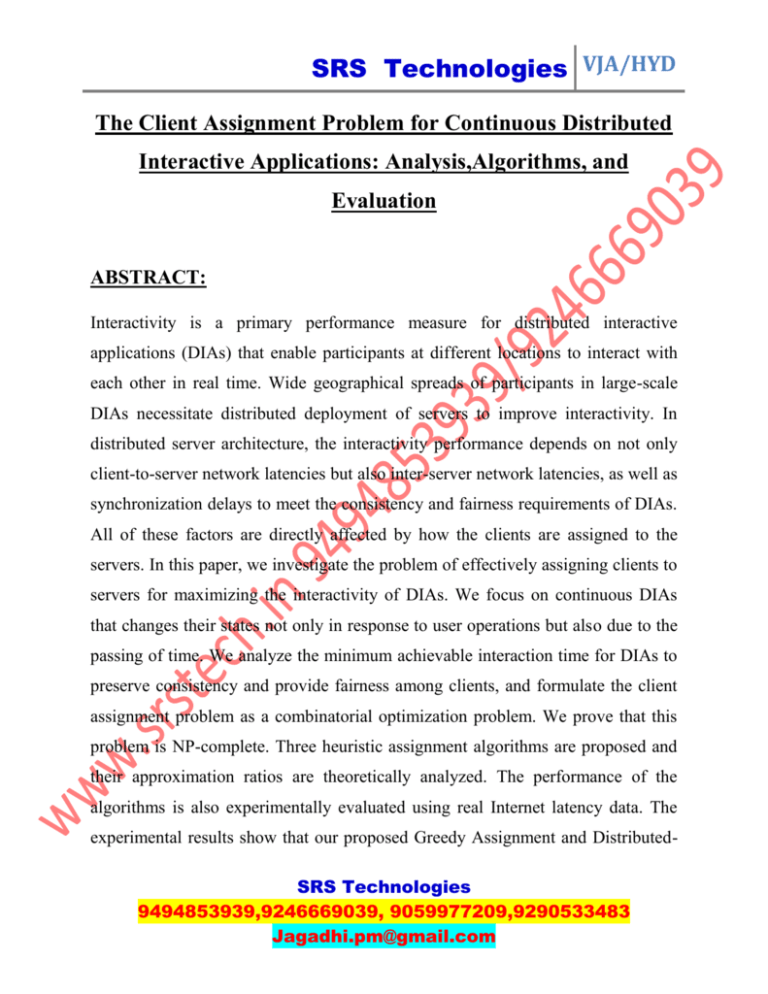
SRS Technologies VJA/HYD The Client Assignment Problem for Continuous Distributed Interactive Applications: Analysis,Algorithms, and Evaluation ABSTRACT: Interactivity is a primary performance measure for distributed interactive applications (DIAs) that enable participants at different locations to interact with each other in real time. Wide geographical spreads of participants in large-scale DIAs necessitate distributed deployment of servers to improve interactivity. In distributed server architecture, the interactivity performance depends on not only client-to-server network latencies but also inter-server network latencies, as well as synchronization delays to meet the consistency and fairness requirements of DIAs. All of these factors are directly affected by how the clients are assigned to the servers. In this paper, we investigate the problem of effectively assigning clients to servers for maximizing the interactivity of DIAs. We focus on continuous DIAs that changes their states not only in response to user operations but also due to the passing of time. We analyze the minimum achievable interaction time for DIAs to preserve consistency and provide fairness among clients, and formulate the client assignment problem as a combinatorial optimization problem. We prove that this problem is NP-complete. Three heuristic assignment algorithms are proposed and their approximation ratios are theoretically analyzed. The performance of the algorithms is also experimentally evaluated using real Internet latency data. The experimental results show that our proposed Greedy Assignment and DistributedSRS Technologies 9494853939,9246669039, 9059977209,9290533483 Jagadhi.pm@gmail.com SRS Technologies VJA/HYD Modify Assignment algorithms generally produce near optimal interactivity and significantly reduce the interaction time between clients compared to the intuitive algorithm that assigns each client to its nearest server. EXISTING SYSTEM: Distributed interactive applications (DIAs), such as multiplayer online games and distributed interactive simulations, allow participants at different locations to interact with one another through networks. Thus, the interactivity of DIAs is important for participants to have enjoyable interaction experiences. Normally, interactivity is characterized by the duration from the time when a participant issues an operation to the time when the effect of the operation is presented to the same participant or other participants . We refer to this duration as the interaction time between participants. Network latency is known as a major barrier to provide good interactivity in DIAs . It cannot be eliminated from the interactions among participants and has a lower theoretical limit imposed by the speed of light. DISADVANTAGES OF EXISTING SYSTEM: 1. Interaction between the client and server not much effective. 2. It has more Network latency which barries interactive of DIA. PROPOSED SYSTEM: SRS Technologies 9494853939,9246669039, 9059977209,9290533483 Jagadhi.pm@gmail.com SRS Technologies VJA/HYD In this paper, we investigate the problem of effectively assigning clients to servers for maximizing the interactivity of DIAs. We focus on continuous DIAs that change their states not only in response to user-initiated operations but also due to the passing of time Several heuristic assignment algorithms are then proposed. Their approximation ratios are theoretically analyzed. The performance of the algorithms is also experimentally evaluated using real Internet latency data. The results show that our proposed Greedy Assignment and Distributed-Modify Assignment algorithms generally produce near optimal interactivity and significantly reduce the interaction time between clients compared to the intuitive Nearest-Server Assignment algorithm that assigns each client to its nearest server. Distributed-Modify Assignment also has good adaptivity to dynamics in client participation and network latency. ADVANTAGES OF PROPOSED SYSTEM: 1. Reducing network latency for improving interactivity in DIAs. 2. Server calculation more effective than existing system. SYSTEM REQUIREMENTS: HARDWARE REQUIREMENTS: System Hard Disk : Pentium IV 2.4 GHz. : 40 GB. SRS Technologies 9494853939,9246669039, 9059977209,9290533483 Jagadhi.pm@gmail.com SRS Technologies VJA/HYD Floppy Drive : 1.44 Mb. Monitor : 15 VGA Colour. Mouse : Logitech. Ram : 512 Mb. SOFTWARE REQUIREMENTS: Operating system : Windows XP/7. Coding Language : JAVA/J2EE IDE : Netbeans 7.4 Database : MYSQL REFERENCE: Lu Zhang and Xueyan Tang, “The Client Assignment Problem for Continuous Distributed Interactive Applications: Analysis, Algorithms, and Evaluation” IEEE TRANSACTIONS ON PARALLEL AND DISTRIBUTED SYSTEMS,VOL. 25,NO.3,MARCH 2014. SRS Technologies 9494853939,9246669039, 9059977209,9290533483 Jagadhi.pm@gmail.com
